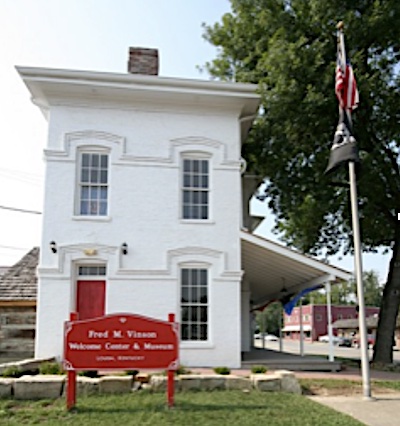BORN IN A LOUISA JAILHOUSE
ByJohn Butch Preston
It was an unusual jail: constructed of huge limestone blocks that were attached to the long backside of the jailer’s residence, with the entrance to the cells located in a room on the second floor of the two-story house. The jailer’s young son played there and one day one of the prisoners befriended him and asked him, perhaps as a joke, to slip a hatchet through the bars to him. The boy, eager to please, rushed to find a hatchet, but his father intervened.

The boy, born in 1890, would grow up to die of a heart attack in 1953 at his residence in Washington D. C. at the age of 63. Whereupon President Dwight Eisenhower proclaimed a 30-day period of mourning and ordered flags flown at half-staff on all federal buildings in the United States and abroad. Indeed, what would Washington and the world do now without the affable genius of one of Americas greatest men, Fred M. Vinson of Louisa, Kentucky.
After graduating from Centre College law school with the highest-grade average in the school’s history, he became Louisa’s Commonwealth attorney. He then won a seat in congress as a Democrat, where he eventually distinguished himself while serving on the important Ways and Means Committee; and while there appropriated funds to build the Portsmouth, Russel, and Kenova bridges. But that was small potatoes.
Newly elected President Franklin D. Roosevelt immediately recognized his talent and invited him into his cabinet as an adviser. From that position he helped develop and push through congress Roosevelt’s 1935 Social Security and Workman’s Disability Insurance Act. So thanks in part to Vinson we all have a safety net after retirement and food on the table if injured on the job. Roosevelt then tapped him to revamp the tax codes, especially capital gains, resulting in millions of dollars added to the Treasury.
For these endeavors, Roosevelt awarded him the chief judgeship on the Emergency Court of Appeals. But as inflation in American began to get out of control at the beginning of WW II, he was brought back into the executive branch as Economic Stabilization Director where he masterfully manipulated wages and prices and held inflation at 3 percent. Then as America entered the war, he was made Federal Loan Administrator along with the position of Director of War Mobilization and Reconversion. Given an office in the White House for these duties, he became known as the “Assistant President.”
At the close of the war the new president Harry Truman needed someone to oversee the international conference for war reconstruction and chose the only person he knew could do the job, making Vinson Secretary of State, who then created the World Bank and set up the International Monetary Fund based on the American gold-backed dollar—a forerunner of the Marshal Plan.
Not long afterwards Chief Justice of the Supreme Court Harlan Stone died and who else, but Vinson would be nominated and unanimously approved as Chief Justice. In cases involving labor disputes and such he sided with the U, S. Government, believing that a strong central government was more important than the rights of labor. But near the end, just before he died, segregation cases began coming up vis a vis the Fourteenth Amendment; and he knew emphatically that “separate but equal” was the biggest fiction ever perpetrated on the American public. So when a school segregation case was sent back to a lower court he wanted it brought back and reexamined. But he died before this could happen. That case eventually led to Brown v. Board of Education.
When President Truman decided not to seek a second term, all of Washington expected Vinson to run in his place, as he was ahead of all other candidates in the polls, but, wise as he was until the end, he was too satisfied in his role as non-partisan Chief Justice to even consider it. He had long since done his duty and more for the country.
The Fred M. Vinson Museum, on the National Register of Historical Places, is located at the end of Madison Street in Louisa at the foot of the Fort Gay Bridge (where you can walk out and watch the Tug and Levisa Forks flow together to form the Big Sandy River).
The museum is of course in the same house Vinson was born in, but the limestone jail structure has long been removed except for one cell repositioned on the ground floor which faces you like a dark cavern when you walk through the front door, beckoning you to enter it where jailhouse artifacts of that era can be found. The original plank flooring and floor to ceiling windows make for a pleasant atmosphere as you stroll around looking at all the memorability on display, such as Paper money of different denominations bearing Vinson’s signature from when he was Secretary of the Treasury. There are guides there to assist you, and they request you call ahead for the hours and days that it is open.













![Foothills-Bundle] Foothills-Bundle](https://thelevisalazer.com/wp-content/uploads/2020/05/Foothills-Bundle-422x74.jpg)





Lived in Louisa now for 10 years and always wondered who Fred Vinson was. Now I know.
I was born in 1953 and my mother has always told about watching Fred M. Vinson’s funeral procession pass by, all the black cars carrying various dignitaries who attended the funeral.
Very good story.
I was in Grade School in Fort Gay. I heard there was a great man, the Chief Justice of the Supreme court had died and was at the Curtright Funeral Home. I had never seen a great man. I rode my bicycle over the old toll bridge to the funeral home to see him.